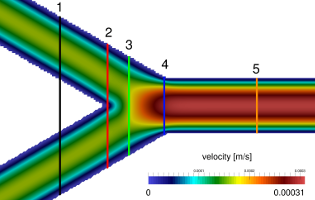Introduction to the Lattice Boltzmann Method
There are two main approaches in simulating the transport equations (heat, mass, and momentum), continuum (in Eulerian frame of reference), and discrete (in Lagrangian frame of reference). In a continuum approach, ordinary or partial differential equations set can be achieved by applying laws of conservation of energy, mass, and momentum for an infinitesimal control volume. Since it is difficult or in most practical cases not possible to solve the governing differential equations, therefore finite difference, finite volume, finite element, etc., schemes are used to convert the differential equations with a given boundary and initial conditions into a system of algebraic equations. The algebraic equations can be solved iteratively until convergence is insured and as result, we obtain distributions of macroscopic quantities such as velocity, density, temperature, etc. [Mohamad 2011].
In contrast, the lattice Boltzmann method (LBM), developed about two decades ago (McNamara and Zanetti 1988), is a Lagrangian approach at the mesoscopic level. LBM studies the microdynamics of fictitious particles by using simplified kinetic models. It provides an alternative way for simulating fluid flows. The kinetic nature brings many distinctive features to LBM such as the clear picture of streaming and collision processes of simulated fluid particles, the simple algorithm structure, the easy implementation of boundary conditions, and the natural parallelism. These appealing features make LBM a powerful numerical tool for simulating fluid systems involving complex physics [Guo and Shu 2013]. The working horse of the lattice-Boltzmann method is the discretized in momentum space form of the Boltzmann transport equation.
Sauro Succi in his book [Succi 2009] summarized the main lattice-Boltzmann equation properties as follows:
-
- Mathematical
-
- Hyperbolic superset of the Navier-Stokes equations.
- Linear streaming operator.
- Stokes advection.
- Nonlinearity hidden in a local collision operator, and formally separated from streaming.
-
- Physical
-
- Sound, as it is derived entirely within the statistical mechanics framework.
- Simple, sa it is based on clear-cut stream-collide dynamics.
- Flexible towards additional (mesoscopic) physics.
-
- Numerical
-
- Explicit, synchronous.
- Second-order space-time accurate.
- Advection-limited time-step.
- Unconditionally linearly stable.
- Conditionally nonlinearly stable.
-
- Computational
-
- Efficient on serial computers.
- Outstanding on parallel ones.
-
- Mathematical
In the LBM, as in the conventional CFD, the geometry, initial and boundary conditions must be specified to solve the initial-value problem. The computational domain is uniformly partitioned and computational nodes are placed in vertices of adjacent cells, giving the lattice.

